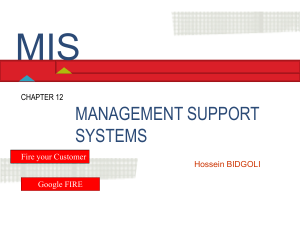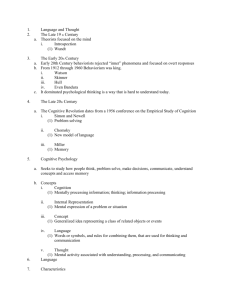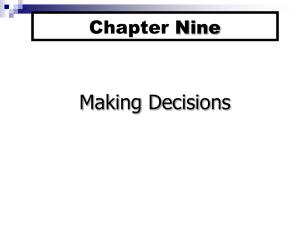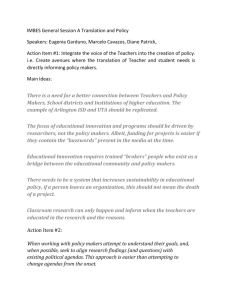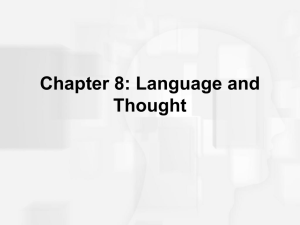Additional_notes
advertisement
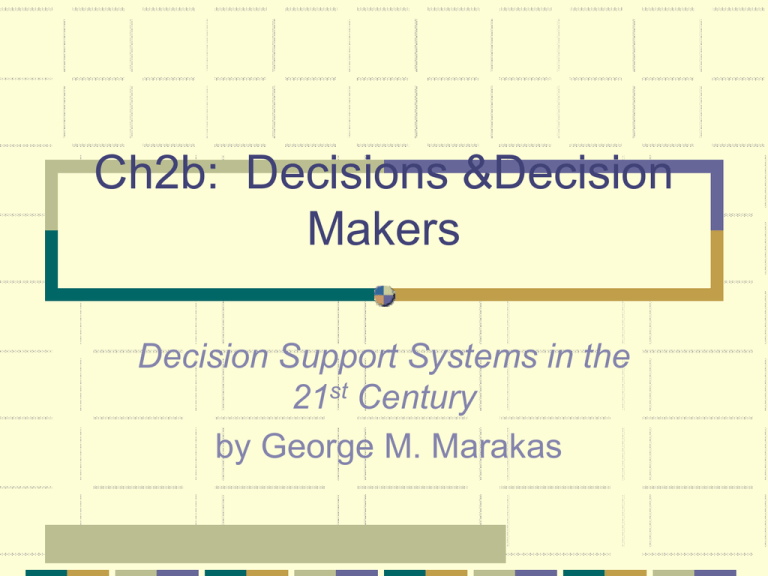
Ch2b: Decisions &Decision Makers Decision Support Systems in the 21st Century by George M. Marakas 2-1: Why are Decisions So Hard? The four key areas that determine the relative difficulty of a decision are: 1. 2. Structure – in general, the more structure, the less information required Cognitive limitations – the human mind is limited to handling 5 to 9 distinct pieces of information 2-1: Why are Decisions So Hard? (cont.) The four key areas that determine the relative difficulty of a decision are: 3. 4. Uncertainty – the amount is based on how complete and accurate the information is Alternatives and multiple objectives – the selection of one alternative may impede the progress towards a different goal Continuum of Decision Structures Simon’s Model of Problem Solving Simon proposed a three-phase model of problem solving: 1. 2. 3. Intelligence phase – the decision maker looks for indications that a problem exists Design phase – alternatives are formulated and analyzed Choice phase – one of the alternatives is selected and implemented Simon’s Model of Problem Solving 2-4: Rational Decision Making Many decision strategies (next slide) attempt to find optimal solutions. In many circles, this is considered to be rational behavior. It is not always possible to optimize. Some problems have only qualitative solutions. Others may be quantitative but have multiple objectives at odds with others. In such situations, rational behavior would be to choose a “good” solution. Modeling and Analysis Strategies Satisficing strategies: Simulation Forecasting “What if” analysis Markov analysis Complex queuing methods Environmental impact analysis Optimizing strategies: Linear programming Goal programming Simple queuing models Investment models Inventory models Transportation models 2-5: Bounded Rationality Simon argued that people don’t always optimize because it is often impractical to consider all possible solutions to a problem. He notes that we often “simplify reality” by looking for a solution that is acceptable, a strategy he called satisficing. When people make rational decisions that are bounded by often uncontrollable constraints, he notes that they are operating inside bounded reality. Optimizing Versus Satisficing Optimizing strategies search here Satisficing strategies search here Bounded Reality and DSS Design Left alone, a decision maker preconceives the structure of a desired solution before the search for it begins. By using a DSS, the decision maker can learn to avoid placing too many constraints too early on the solution. In short, using a DSS would at least “loosen the bounds”. Using a DSS can also help the decision maker solve the problem rather than simply treating the problem’s symptom. 2-7: Cognitive Processes Decision makers face a formidable task if they are to overcome all the factors contributing to cognitive limitations: Humans can only retain a few bits of information in short-term memory. Decision makers display differing intelligence. Some decision makers tend to restrict their search. Decision makers that employ concrete thinking tend to be limited information processors. 2-7: Cognitive Processes (cont.) Decision makers face a formidable task if they are to overcome all the factors contributing to cognitive limitations: Propensity for risk varies among decision makers. Decision maker’s level of aspiration is positively correlated with desire for information. In general, older decision makers appear to be more limited than younger ones. Perception This is a special type of cognitive limitation. Common perception blocks are: Difficulty in isolating the problem. Delimiting the problem space too closely. Inability to see the problem from different perspectives. Stereotyping. Cognitive saturation or overload. Judgment Although numerous strategies exist for evaluation of solution alternatives, judgment appears to be the most favored. Compared to detailed analysis, judgment is faster, more convenient, and less stressful. When applied in isolation, however, judgment may be nothing but a guess. One reason why it may not be used exclusively is that it relies heavily on the decision maker’s recollection, which may fail. 2-8: Biases and Heuristics In Decision Making We all have “rules of thumb” that we rely on in making decisions. Another term for such rules is heuristics. Heuristic search techniques follow a series of steps based on “rules” developed by experience. These searches can often provide solutions very close to those found by exhaustive search. Advantages of Heuristics in Problem Solving Simple to understand Easy to implement. Requires less conception time. Requires less cognitive effort. Can produce multiple solutions. Appropriate Uses of Heuristics in Problem Solving Input data are inexact or limited. High computation time for an optimal solution. Problems are solved frequently and repeatedly. Symbolic processing is involved. A reliable, exact method is not available. Optimization is not economically feasible. Traveling Sales man Problem Cities to Visit Initial Heuristic Solution Rule: start at home, go to closest city Modified Heuristic Solution Rule: no crossing any connection, no backtracking Heuristic Bias Sometimes the use of heuristics can hamper finding a solution. The four major categories of bias are: 1. Availability – people tend to estimate probability based on past experience, which may not be representative. 2. Adjustment and anchoring – people often pick a starting value and then adjust up and down from it. They tend to underestimate the need for adjustments. Heuristic Bias (cont.) Sometimes the use of heuristics can hamper finding a solution. The four major categories of bias are: 3. Representativeness – people tend to misestimate probabilities of belonging to a group. 4. Motivational – incentives often lead decision makers to estimate probabilities that do not reflect their true beliefs. 2-9: Effectiveness and Efficiency Effectiveness of DSS: Easier access to information Faster problem recognition and identification Easier access to computing tools Greater ability to evaluate large choice sets Efficiency from DSS: Reduction in decision costs Reduction in decision time Better quality in feedback supplied


